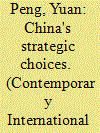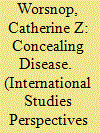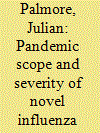| Srl | Item |
| 1 |
ID:
094084


|
|
|
| 2 |
ID:
169259


|
|
|
|
|
| Summary/Abstract |
Slow outbreak reporting by states is a key challenge to effectively responding to global health emergencies like Zika, Ebola, and H1N1. Current policy focuses on improving domestic outbreak surveillance capacity globally in order to reduce reporting lags. However, governments also face economic and political incentives to conceal outbreaks, and these incentives largely are ignored in policy discussions. In spite of the policy implications for outbreak response, the “capacity” and “will” explanations have not been systematically examined. Analysis of a dataset coding the timeliness of outbreak reporting from 1996–2014 finds evidence that states’ unwillingness to report—rather than just their inability—leads to delayed reporting. The findings suggest that though building surveillance capacity is critical, doing so may not be sufficient to reduce reporting lags. Policy aimed at encouraging rapid reporting must also mitigate the associated economic and political costs.
|
|
|
|
|
|
|
|
|
|
|
|
|
|
|
|
| 3 |
ID:
091372


|
|
|
| 4 |
ID:
103475


|
|
|
|
|
| Publication |
2011.
|
| Summary/Abstract |
In fall 2009, the New York City Department of Health and Mental Hygiene (DOHMH) operated 58 points of dispensing (PODs) over 5 weekends to provide influenza A (H1N1) 2009 monovalent vaccination to New Yorkers. Up to 7 sites were opened each day across the 5 boroughs, with almost 50,000 New Yorkers being vaccinated. The policies and protocols used were based on those developed for New York City's POD Plan, the cornerstone of the city's mass prophylaxis planning. Before the H1N1 experience, NYC had not opened more than 5 PODs simultaneously and had only experienced the higher patient volume seen with the H1N1 PODs on 1 prior occasion. Therefore, DOHMH identified factors that contributed to the success of POD operations, as well as areas for improvement to inform future mass prophylaxis planning and response. Though this was a relatively small-scale, preplanned operation, during which a maximum of 7 PODs were operated on a given day, the findings have implications for larger-scale mass prophylaxis planning for emergencies.
|
|
|
|
|
|
|
|
|
|
|
|
|
|
|
|